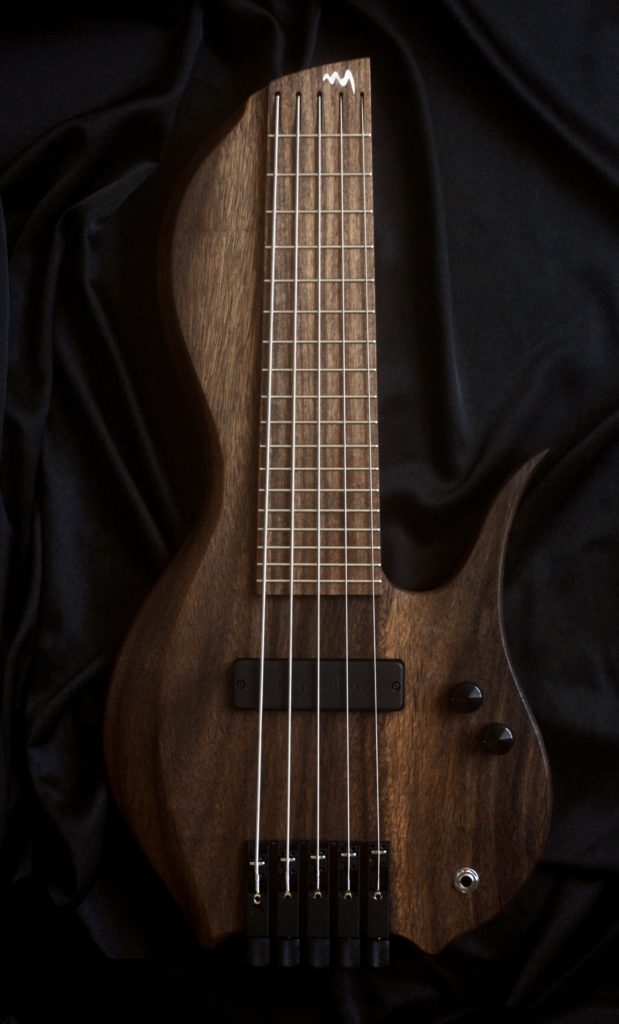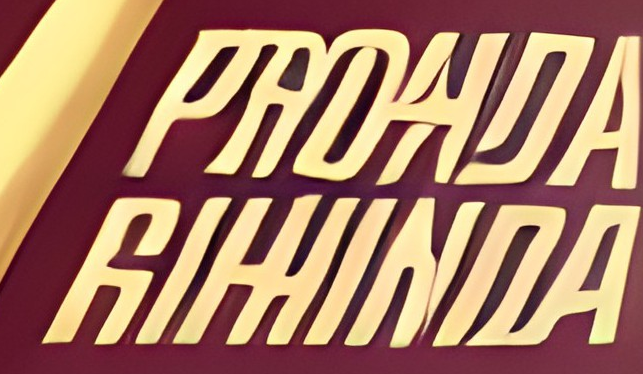Big day for packages yesterday. First… the Miezo!



Maurizio Über Basses (MÜB) Miezo 18. Raintree body, ovangkol fretboard, mother of pearl side dots. 5 strings, 17mm spacing, ETS headless tuning system. Bartolini dual coil pickup, simple volume and tone knobs.
Tuning is an octave above a standard BEADG 5-string bass, or two semitones down from there (ADGCF, where the lowest string is the same as the second-lowest on a standard 4-string bass). “Cello range” essentially, and very good for my needs since it’s where I tended to play on the other basses anyway. And speaking of tuning, those tuners are a joy to work with, very responsive and precise — I fell in love with those immediately.
It looks even nicer in person than in the photo. The two woods match extremely well, almost looking like a single piece of wood, which is the effect I wanted.
The feel of the instrument is solid; it gives an impression of being heavy but the actual weight is lighter than a full-sized bass, just concentrated, if that makes sense. The balance with the strap buttons is perfect for playing while seated. The instrument is right up against the body, very well suited to sitting at my studio desk and alternately playing the bass and synths.
The sound is 100% right. Despite being a slightly higher register and much shorter strings than a standard bass, it’s not lacking in anything. It’s both solid and clear, a perfect basis for either leaving clean or processing it heavily. The tone knob, which I usually favor going full open, rolls off the top end to a warm glow that’s also pretty pleasant. There is a small amount of electromagnetic hum/buzz despite the dual coil and copper shielding (I think it’s a difficult room) but below the noise level of the Mikro and easy to clean up in the DAW. I haven’t tested to see whether the pickups get signals from the Strega touchplates like the Mikro does.
The strings are round-wound, which means I need to be more precise about fretting or pay the squeaky, clanky consequences. While I find I prefer the feel of flatwound or tapewound, for now I’m not going to change the strings, but try to improve my own technique instead. On the Mikro I feel like the tapewound strings are a little duller in tone.
Going from 4 strings to 5 isn’t much of an adjustment. It’s a little wider area to mute, and I find that playing higher frets on the lowest string is a bit more challenging (but hey, just go up a string and play lower frets). The differently shaped neck means I have to fix the bad habit of wrapping my thumb around the neck, but the overall shape and angle also make that an easy fix. And the string tension feels a bit different but not something that will throw me off.
The instrument came with a nice custom padded gig bag with a velcro strap to keep the neck secure and a flat zippered pocket on the outside. The big padded strap I have on it right now (yanked off the 30″ bass upstairs that never gets played) fits a bit awkwardly in the bag though.
Overall it was 132 days between putting down my deposit and receiving the finished instrument (including 6 days for shipping). From other peoples’ experiences I’d expected approximately 90, with a lot of wiggle room, but I but didn’t actually ask at the beginning of the process. It was well worth the wait, though.
This is going to be my main bass for sure. But I still like fretless too, and I expect the Hadean bass uke will continue to serve me in that role for a good while. 🙂
The other new thing is the WMD Synchrodyne module. I owned one before, found it interesting but chaotic, and gave it up when I was specializing in particular areas of synthesis. I’ve been missing it, and since switched-capacitor filters are so rare in Eurorack and WMD going out of business is only going to make them rarer, decided to get one.
Time tends to blunt the details of memories of things like sound and subtleties of module behavior. This is to say that Synchrodyne is way weirder than I actually remembered. It’s hard to make it pretend to be a clean filter; it’s very easy to make it pretend to be 73 kinds of dirty filters, some of them simultaneously. Synchrodyne and Strega have already sworn a blood pact and are busy summoning a dark horde to take over the rest of the modular. In other words — they are very complimentary in their noisy, scraping, pulsating gloom. I love it.
Compared to Inertia as a filter, it is far more diverse but a little harder to tame or control. Inertia of course is also a slew, envelope generator, LFO and oscillator (varying from sine to saw-like in a fairly smooth way). Synchrodyne has a saw-core oscillator (with secondary pulse output) and PLL. So one does not replace the other completely, which would make life just slightly easier but I suppose, just slightly less interesting. 🙂







